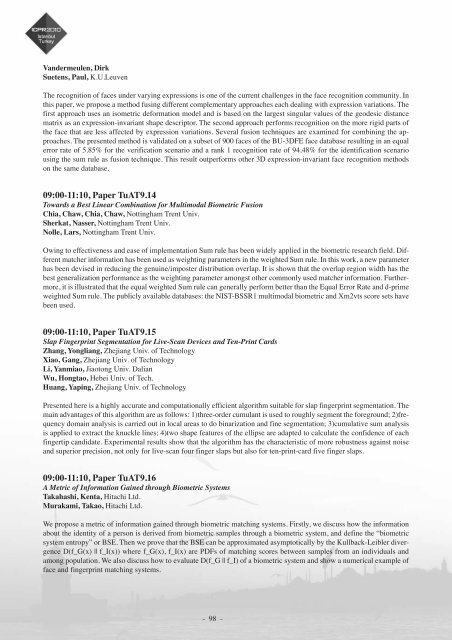Abstract book (pdf) - ICPR 2010
Abstract book (pdf) - ICPR 2010
Abstract book (pdf) - ICPR 2010
- TAGS
- abstract
- icpr
- icpr2010.org
Create successful ePaper yourself
Turn your PDF publications into a flip-book with our unique Google optimized e-Paper software.
Vandermeulen, Dirk<br />
Suetens, Paul, K.U.Leuven<br />
The recognition of faces under varying expressions is one of the current challenges in the face recognition community. In<br />
this paper, we propose a method fusing different complementary approaches each dealing with expression variations. The<br />
first approach uses an isometric deformation model and is based on the largest singular values of the geodesic distance<br />
matrix as an expression-invariant shape descriptor. The second approach performs recognition on the more rigid parts of<br />
the face that are less affected by expression variations. Several fusion techniques are examined for combining the approaches.<br />
The presented method is validated on a subset of 900 faces of the BU-3DFE face database resulting in an equal<br />
error rate of 5.85% for the verification scenario and a rank 1 recognition rate of 94.48% for the identification scenario<br />
using the sum rule as fusion technique. This result outperforms other 3D expression-invariant face recognition methods<br />
on the same database.<br />
09:00-11:10, Paper TuAT9.14<br />
Towards a Best Linear Combination for Multimodal Biometric Fusion<br />
Chia, Chaw, Chia, Chaw, Nottingham Trent Univ.<br />
Sherkat, Nasser, Nottingham Trent Univ.<br />
Nolle, Lars, Nottingham Trent Univ.<br />
Owing to effectiveness and ease of implementation Sum rule has been widely applied in the biometric research field. Different<br />
matcher information has been used as weighting parameters in the weighted Sum rule. In this work, a new parameter<br />
has been devised in reducing the genuine/imposter distribution overlap. It is shown that the overlap region width has the<br />
best generalization performance as the weighting parameter amongst other commonly used matcher information. Furthermore,<br />
it is illustrated that the equal weighted Sum rule can generally perform better than the Equal Error Rate and d-prime<br />
weighted Sum rule. The publicly available databases: the NIST-BSSR1 multimodal biometric and Xm2vts score sets have<br />
been used.<br />
09:00-11:10, Paper TuAT9.15<br />
Slap Fingerprint Segmentation for Live-Scan Devices and Ten-Print Cards<br />
Zhang, Yongliang, Zhejiang Univ. of Technology<br />
Xiao, Gang, Zhejiang Univ. of Technology<br />
Li, Yanmiao, Jiaotong Univ. Dalian<br />
Wu, Hongtao, Hebei Univ. of Tech.<br />
Huang, Yaping, Zhejiang Univ. of Technology<br />
Presented here is a highly accurate and computationally efficient algorithm suitable for slap fingerprint segmentation. The<br />
main advantages of this algorithm are as follows: 1)three-order cumulant is used to roughly segment the foreground; 2)frequency<br />
domain analysis is carried out in local areas to do binarization and fine segmentation; 3)cumulative sum analysis<br />
is applied to extract the knuckle lines; 4)two shape features of the ellipse are adapted to calculate the confidence of each<br />
fingertip candidate. Experimental results show that the algorithm has the characteristic of more robustness against noise<br />
and superior precision, not only for live-scan four finger slaps but also for ten-print-card five finger slaps.<br />
09:00-11:10, Paper TuAT9.16<br />
A Metric of Information Gained through Biometric Systems<br />
Takahashi, Kenta, Hitachi Ltd.<br />
Murakami, Takao, Hitachi Ltd.<br />
We propose a metric of information gained through biometric matching systems. Firstly, we discuss how the information<br />
about the identity of a person is derived from biometric samples through a biometric system, and define the “biometric<br />
system entropy” or BSE. Then we prove that the BSE can be approximated asymptotically by the Kullback-Leibler divergence<br />
D(f_G(x) || f_I(x)) where f_G(x), f_I(x) are PDFs of matching scores between samples from an individuals and<br />
among population. We also discuss how to evaluate D(f_G || f_I) of a biometric system and show a numerical example of<br />
face and fingerprint matching systems.<br />
- 98 -



